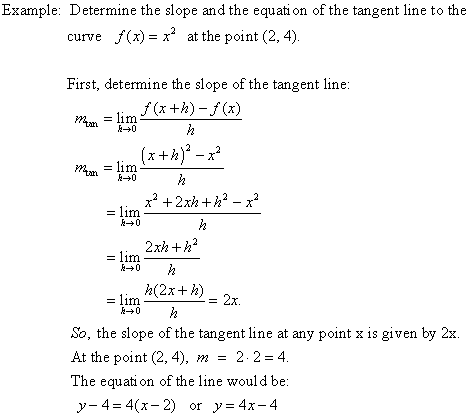Lesson #20
Rates of Change and Velocity
|
Quote of the Day:
"The shortest distance between two points is under construction."
-- Bill Sanderson
Objectives:
The student will determine the Average Rate of Change
of a function over a given interval.
The student will determine the Instantaneous Rate of
Change of a function at a given point.
The student will determine the average velocity of a given function
over a given time interval.
The student will determine the instantaneous velocity of a given function
at a particular time.
1. Bellringer:
A. Problem:
You make a roundtrip from Winchester to Harrisonburg,
a distance of 60 miles one way (actually, any distance
will work in this problem). If you travel down at
30 m.p.h., and return at 60 m.p.h., what was your
average m.p.h. over the whole trip?
Use the following table to help answer the problem:
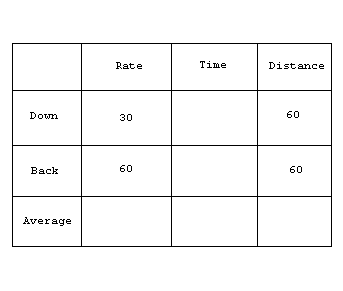
2. Average Rate of Change vs. Instantaneous Rate of Change
Slope of a secant line vs. Slope of a tangent line
Average velocity vs. Instantaneous velocity
Slope is a rate of change of y with respect to x.
Average rate of change takes place over an interval
while instantaneous rate of change takes place at an
instant.
Average velocity occurs over a specific time interval
while instantaneous velocity is what is shown on your
speedometer.
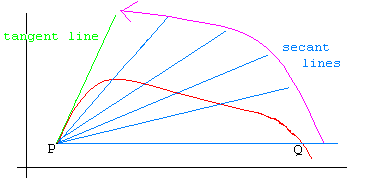
If a secant line is drawn between two points, P and Q, on a curve y = f(x), and if Q is allowed to move along the curve toward P, then the secant line will rotate toward a limiting position (which is the tangent line at P). 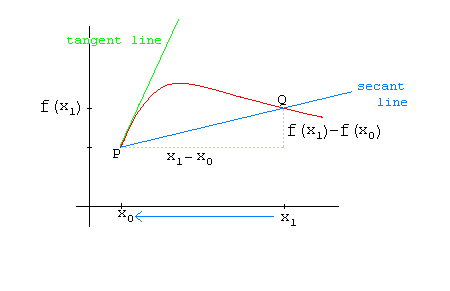
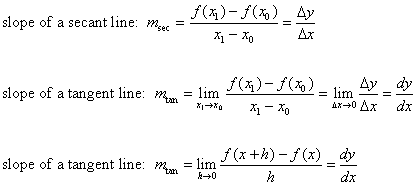
3. Examples:
In Mount Rainier National Park, here are some of the
hiking trails in the Longmire area:
(1) Trail of the Shadows:
.7 miles round-trip;
average hiking time is 30 minutes.
(2) Carter Falls/Madcap Falls:
2.2 miles round-trip; 500' elevation gain;
average hiking time: 2 hours.
(3) Rampart Ridge:
4.6 mile loop; 1,339' elevation gain;
average hiking time: 2.5 hours.
(4) Comet Falls and Van Trump Park:
5.6 miles round-trip; 2,200' elevation gain;
average hiking time: 4 hours.
(5) Wonderland Trail to Indian Henry's:
6.7 miles one way ; 2,400' elevation gain;
average hiking time: 4 hours.
(6) Wonderland Trail to Paradise:
6 miles one way; 2,700' elevation gain;
average hiking time: 3 hours.
(7) Eagle Peak Saddle:
7.2 miles round trip; 2,955' elevation gain;
average hiking time: 5 hours.
Determine the AVERAGE RATE OF CHANGE OF THE DISTANCE WITH RESPECT
TO TIME of some of the trails.
Determine the AVERAGE RATE OF CHANGE OF THE ELEVATION WITH RESPECT
TO THE HORIZONTAL DISTANCE (you must solve for this
horizontal distance since the information given is the
elevation and the distance traveled).
4. Displacement, Average Velocity, and Instantaneous Velocity
One of the most important concepts in calculus is the study of motion.
Speed is how fast an object is going.
The speed and the direction make up the velocity (it is a vector quantity).
Displacement is the change in position (the difference between the initial and final position).
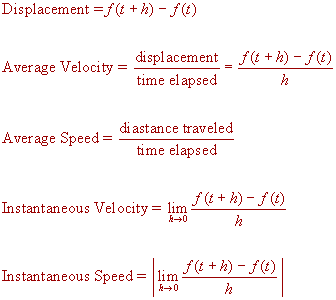
5. Assignment:
Read pages 165 - 175
p. 176 (1, 9, 19, 20)
|
